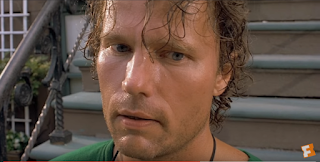The scene previous to this one involved the main character, Mookie. In order to make a smooth transition into a scene that centered around Buggin' Out, the scene starts with Mookie and his coworker stepping out into the street. The two engage in a casual conversation and then Buggin' Out appears and greats Mookie. After this, Mookie and his coworker walk away. Directly after they exist, the stranger enters the shot and pushes into Buggin' Out. This is what leads to the altercation that the scene is centered around. What makes the transition from the previous scene to this one so smooth is that Buggin' Out makes a natural entrance into the scene. Rather than there being an abrupt change in scenery, the scene starts with the characters from the previous scene entering a new exterior space and interacting with the character that the focus shifts to. It is from that point that the scene begins to develop.
During the conversation between Mookie and Buggin' Out, the shot is positioned as a medium close-up with a side view of the two characters. Mookie's co-worker, Vito, is positioned on the opposite side of the camera. Vito is shown head-on and more of his body is shown than the other two characters, making him appear more exposed. This works with the film since Vito is one of the very few white characters who inhabits the dominantly black neighborhood that the film takes place in, making him stand out. Mookie and Vito exit and the stranger enters from the same direction as the exiting characters. The stranger comes from off screen and immediately bumps into Buggin' Out. This makes the viewer just as surprised by the character as Buggin' Out is. Buggin' Out then looks down and sees that the stranger scuffed his sneaker. There is an extreme close-up of the scuff mark which quickly zooms out to show the whole sneaker. This is a great shot in that it reflects how severe the action of scuffing his sneaker was, rather than allowing it to seem like a casual occurance that isn't that big of a deal.




We then follow Buggin' Out with a tracking shot that shows him from the side as he chases down the stranger. By showing this from the side, it allows the viewers to see the onlookers from the sidewalk start to be become aware of the situation, which explains why they all crowd around Buggin' Out while he argues with the stranger. The film incorporates shot/reverse-shot during the argument between the two, showing Buggin' Out with many members of the neighborhood beside him. The stranger, on the other hand, is alone with a set of stairs shown closely behind him, giving the impression that he is up against a wall. This set of shots does a good job of showing the support that Buggin' Out has in contrast to the vulnerability that the stranger has through being a white person in a black neighborhood.


No comments:
Post a Comment